Giant algae Study guides, Revision notes & Summaries
Looking for the best study guides, study notes and summaries about Giant algae? On this page you'll find 32 study documents about Giant algae.
All 32 results
Sort by
 Popular
Popular
-
Illinois Aquatics Pesticide License questions and answers
- Exam (elaborations) • 4 pages • 2023
- Available in package deal
-
- £11.48
- 1x sold
- + learn more
plants without stems, leaves, or vascular systems algae three types of algae microscopic, filamentous, chara turn water green, phytoplankton, turnover in spring microscopic algae blue-greem streaks, HAB cyanobacteria grows at surface or on submerged plants in mats, issue in cooling tower veins filamentous algae pond moss, spirogyra, cladophora, pithophora, hydrodictyon filamentous algae branching algae, needle leaves chara stonewort and mus...
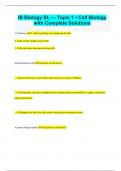
-
IB Biology SL — Topic 1 • Cell Biology with Complete Solutions
- Exam (elaborations) • 25 pages • 2024
- Available in package deal
-
- £8.20
- + learn more
IB Biology SL — Topic 1 • Cell Biology with Complete Solutions Cell theory 1. All living things are composed of cells 2. Cells are the smallest unit of life 3. Cells only arise from pre-existing cells Striated muscle cell Exception to cell theory! → Muscle cells fuse to form fibres that may be very long (>300mm) → Consequently, they have multiple nuclei despite being surrounded by a single, continuous plasma membrane → Challenges the idea that cells always funct...
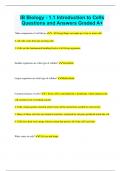
-
IB Biology - 1.1 Introduction to Cells Questions and Answers Graded A+
- Exam (elaborations) • 16 pages • 2024
- Available in package deal
-
- £8.20
- + learn more
IB Biology - 1.1 Introduction to Cells Questions and Answers Graded A+ Main components of cell theory 1. All living things are made up of one or more cells 2. All cells come from pre-existing cells 3. Cells are the fundamental building blocks of all living organisms Smaller organisms are what type of cellular? Unicellular Larger organisms are what type of cellular? Multicellular Common features of cells? 1. Every cell is surrounded by a membrane, which separates the cell contents...

-
IB Biology: Chapter 1 Latest 2024 Graded A+
- Exam (elaborations) • 21 pages • 2024
- Available in package deal
-
- £8.20
- + learn more
IB Biology: Chapter 1 Latest 2024 Graded A+ cell theory - all living things are composed of cells - the cell is the smallest unit of life - cells only arise from pre-existing cells challenges to the cell theory - *striated muscle* challenges the idea that a cell has one nucleus - *giant algae* challenges the idea that cells must be simple in structure & small in size - *aseptate fungal hyphae* challenges the idea that a cell is a single unit functions of life - metabolism - r...
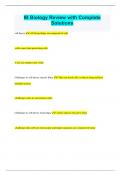
-
IB Biology Review with Complete Solutions
- Exam (elaborations) • 254 pages • 2024
- Available in package deal
-
- £10.66
- + learn more
IB Biology Review with Complete Solutions cell theory -All living things are composed of cells -cells come from preexisting cells -Cells are smallest unit of life Challenges to cell theory: muscle fibres -They are fused cells, so they're long and have multiple nucleus -challenges cells are autonomous units Challenges to cell theory: Giant algae -certain species may grow large -challenges idea cells are microscopic and larger organisms are composed of many Challenges ...

-
IB Biology Unit 1 Latest Update Graded A+
- Exam (elaborations) • 18 pages • 2024
- Available in package deal
-
- £8.20
- + learn more
IB Biology Unit 1 Latest Update Graded A+ Cell theory 3 main principles All organisms are composed of one or more cells cells are the smallest units of life all cells come from pre-existing cells 7 functions of life (MR H GREN) metabolism reproduction homeostasis growth excretion response nutrition Paramecium unicellular membrane of the kingdom known as Protista. Look at powerpoint on isa247 to see how this organism displays the functions of life. chlorella single-cell...
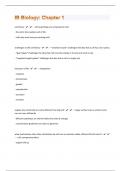
-
IB Biology: Chapter 1|108 Questions with 100% Correct Answers | Verified | Updated 2024
- Exam (elaborations) • 15 pages • 2024
- Available in package deal
-
- £6.56
- + learn more
cell theory - ️️- all living things are composed of cells - the cell is the smallest unit of life - cells only arise from pre-existing cells challenges to the cell theory - ️️- *striated muscle* challenges the idea that a cell has one nucleus - *giant algae* challenges the idea that cells must be simple in structure & small in size - *aseptate fungal hyphae* challenges the idea that a cell is a single unit functions of life - ️️- metabolism - response - homeostasis - gro...
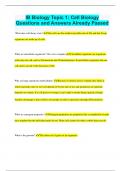
-
IB Biology Topic 1: Cell Biology Questions and Answers Already Passed
- Exam (elaborations) • 20 pages • 2024
- Available in package deal
-
- £8.20
- + learn more
IB Biology Topic 1: Cell Biology Questions and Answers Already Passed What does cell theory state? That cells are the smallest possible unit of life and that living organisms are made up of cells. What are unicellular organisms? Give two examples Unicellular organisms are organisms with only one cell, such as Paramecium and Chlamydomonas. In unicellular organisms the one cell carries out all of the functions of life. Why are large organisms multicellular? Because of surface area to ...

-
Biol 240 - UW - Final Exam questions and answers graded A+
- Exam (elaborations) • 54 pages • 2024
- Available in package deal
-
- £6.56
- + learn more
Not very many proteins in the eukaryotic cytoplasmic membrane. Where did they go? - Answer-They are still in the membrane and they are still busy, but most of the proteins went to the mitochondrial membrane in eukaryotes. Cellulose and Chitin - Answer-Use specific b-1,4-glycosidic bonds between sugars provides strength and rigidity. In algae Fungi - Cell Wall - Answer-You have a NAG in chitin for cell walls in fungi. The cell wall is all NAGs Cytoskeleton Function - Answer-Involved in intr...

-
Marine Biology – 7 Latest Update 100% Pass
- Exam (elaborations) • 9 pages • 2023
- Available in package deal
-
- £8.20
- + learn more
Marine Biology – 7 Latest Update 100% Pass Algae are divided taxonomically into different groups based on differences in: accessory pigments. The macroalgae are commonly known as: seaweeds. The color of light that penetrates seawater to the greatest depth in coastal waters is: green. The depth distribution of algae is limited by: light quality. The compensation depth refers to: the depth which provides only enough light for photosynthesis but not growth. The greatest diversity of algae is...

Did you know that on average a seller on Stuvia earns £76 per month selling revision notes? Hmm, hint, hint. Discover all about earning on Stuvia


